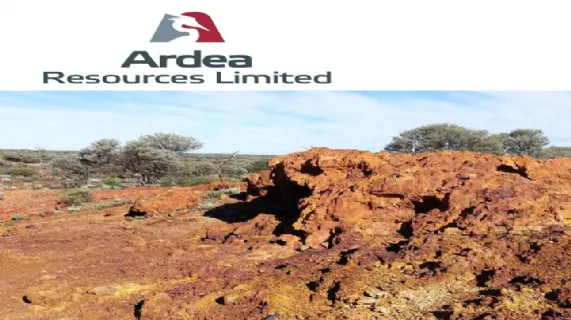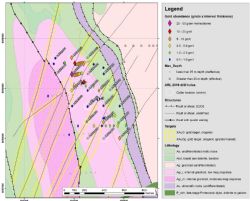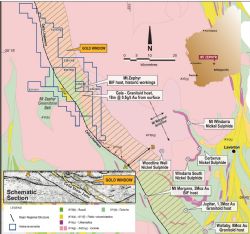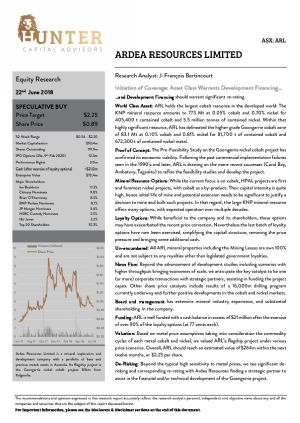
First Pass Drilling at Gale Identifies Large Scale Gold System
Perth, April 11, 2019 AEST (ABN Newswire) - Ardea Resources ( ASX:ARL) (
ASX:ARL) ( ARRRF:OTCMKTS) ("Ardea" or "the Company") is pleased to announce firstpass drill results from the Gale Prospect in the Mount Zephyr greenstone belt of the Eastern Goldfields, Western Australia. The results show downhole continuity of low-grade gold mineralisation reflecting strong, continuous anomalism. Such intercepts are a rarity from a first pass exploration program and are interpreted as the distal, outlying halo of a significant gold mineralising system.
ARRRF:OTCMKTS) ("Ardea" or "the Company") is pleased to announce firstpass drill results from the Gale Prospect in the Mount Zephyr greenstone belt of the Eastern Goldfields, Western Australia. The results show downhole continuity of low-grade gold mineralisation reflecting strong, continuous anomalism. Such intercepts are a rarity from a first pass exploration program and are interpreted as the distal, outlying halo of a significant gold mineralising system.
- Ardea's first pass 160 x 160m spaced RC drilling at the Gale Gold Prospect (Gale) in the Mount Zephyr greenstone belt has intercepted extensive zones of sulphide alteration with low-grade gold mineralisation, demonstrating the gold prospectivity of the broader system.
- Intercepts(see Note below) include:
o AMZR0006: 96.00 m @ 0.28 g/t Au from 2 m
including 22.00 m @ 0.48 g/t Au from 10 m
o AMZR0002: 22.00 m @ 0.25 g/t Au from 6 m
including 4.00 m @ 0.79 g/t Au from 6 m
- Gale drilling results indicate parallels to the Jupiter and Wallaby gold deposits to the south which are bulk tonnage systems located in the hangingwall of the Celia Lineament within granitoid host-rock.
- New targets defined with further drilling required to vector in on higher-grade gold mineralisation.
Commenting on the recent exploration at Mount Zephyr, Ardea CEO Andrew Penkethman said:
"The initial results from the Gale Prospect are an excellent start to Ardea's gold exploration in the Mount Zephyr greenstone belt. Such broad, continuous gold intercepts, which are uncommon from a first phase exploration program, are highly encouraging and warrant further drilling in this underexplored part of the Eastern Goldfields."
Interpretation of Drill Results
Ardea's first drill holes at Gale have successfully defined broad intercepts of strong gold anomalism using wide-spaced drilling (160 x 160 metre pattern) across the sub-cropping part of the prospect. Presently these gold intercepts must be taken as down hole lengths only, as the orientations of the controlling structures are unknown, so true thicknesses cannot be determined. Intercepts include:
AMZR0006: 96.00 m @ 0.28 g/t Au from 2 m
including 22.00 m @ 0.48 g/t Au from 10 m
AMZR0021: 24.00 m @ 0.24 g/t Au from 4 m
AMZR0002: 22.00 m @ 0.25 g/t Au from 6 m
including 4.00 m @ 0.79 g/t Au from 6 m
AMZR0018: 20.00 m @ 0.20 g/t Au from 44 m
Results suggest that late-stage NE-striking structures that cross-cut the Gale granitoid are host to the gold mineralisation. Though none of the broad intercepts are of mineable grade, they represent a strong, anomaly showing that there has been a significant flux of gold mineralising fluids through the rock sequence at Gale.
Definition of near 100 metre thick gold intercepts from a first-pass drill program in the Eastern Goldfields is a rarity, suggesting significant potential for the Gale mineralising system with further drilling warranted to better define the gold distribution.
Mineralisation is highly visual within the host alkaline intrusive and is readily recognised through abundant pyrite and sericite alteration and localised hematite staining. Gold also shows a strong association with typical regional pathfinder elements such as arsenic and antimony, as well as sulphur. These indicators will be important for ongoing recognition of gold mineralisation at Gale and elsewhere within Ardea's contiguous 910 km2 Mt Zephyr-Darlot East tenure.
Defining New Gold Targets at Gale
Gold follows a series of NNE-trending faults. Mineralisation is open, remaining untested to the NNE into the country rock basalts, and to the SSE along structure in the host granitoid, with historic shallow ineffective drilling failing to demarcate the lateral termination of mineralisation. These structures, some of which are defined by their subtle magnetic depletion relative to the host Gale granitoid, are part of a set, so other structures interpreted from geophysical data may be prospective and should also be drill tested.
A series of targets are defined that vastly exceed in area the known current footprint of gold at Gale (see Figure 1 in link below). These will require testing.
Regional setting
The Mount Zephyr greenstone belt is an underexplored supracrustal sequence cross-cut by the gold-fertile Celia Lineament. Gold deposits showing a possible genetic association with the structure include Mt Morgans BIF-hosted mineralisation, Wallaby and Jupiter (both granitoid-hosted deposits). Analogues within Ardea's Mount Zephyr tenure include Dunn's Line (BIF-hosted) and Gale (granitoid-hosted).
The Celia Lineament marks a regionally important structure that has been the focus of both gold-bearing mineralising fluids and intrusion of late-stage, commonly alkaline granitic plugs (see Figure 2 in link below).
Ardea's approach
With Ardea's unencumbered tenure holding, the geology of the Mount Zephyr greenstone belt has never before been defined consistently in such detail. Only now are parallels in the geology being drawn between areas such as the Mount Windarra area and Yamarna regions to the east, and the Kalgoorlie area to the south, highlighting target areas that have previously gone unrecognised. Multiple potential gold and base metal target areas have been defined and ranked and are in the process of being assessed by Ardea.
Initial drill testing has been purposefully broad to enable maximum coverage of ground for minimal cost. Such an approach will detect large-scale systems and, with infill, will allow definition of more moderate sized deposits, if present. First-pass drilling at Gale has defined a large-scale mineralising system that requires further definition. This can be achieved with extension and infill of this first-pass program.
Parallels with Dacian's Jupiter deposit
Both Gale and Dacian's Jupiter deposits rep-resent granitoid-hosted gold mineralisation. Both also occur within the 10 km gold buffer on the eastern side of the Celia Lineament. Jupiter provides a model for exploration at Gale.
The Jupiter deposit lies within the Jupiter Corridor which is defined as a 2 km long north-south trend containing three main syenite bodies (previously mined as the Jupiter Open Pit). Several smaller syenite dykes and intrusive bodies are found proximal to the three main syenites, and all are contained within the Jupiter Corridor. Resources at Jupiter (including stockpiles, as of 31 July 2018) are 33.7 Mt at 1.0 g/t Au for 1,334,000 ounces (Dacian Gold Annual Report 2018, p.13).
Looking Forward at Gale
The next phase of exploration at Gale will consist of designing follow-up drilling. It should be stressed that Ardea holds some 910 km2 of Celia Lineament tenure between Mount Zephyr and Darlot East, has demonstrated the target structures are gold-endowed and drill assay suites confirm the favoured syenitic alkaline granitoid host rock is present. Mount Zephyr is potentially a significant strategic asset.
The Company will continue to keep stakeholders informed on progress and remains committed to maximising value for its shareholders.
Note: Intercepts are down hole thicknesses only. Presently there is insufficient knowledge of the orientations of the controlling structures to gold mineralisation at Gale, so true thickness cannot be calculated.
To view figures, please visit:
http://abnnewswire.net/lnk/32EO6C9G
About Ardea Resources Ltd
 Ardea Resources Ltd (ASX:ARL) (OTCMKTS:ARRRF) (FRA:A91) is an ASX listed resources company, with 100% controlled Australian based projects, prioritising a three-pronged value creation strategy which is:
Ardea Resources Ltd (ASX:ARL) (OTCMKTS:ARRRF) (FRA:A91) is an ASX listed resources company, with 100% controlled Australian based projects, prioritising a three-pronged value creation strategy which is:
- development of the Goongarrie Nickel Cobalt Project, which is part of the Kalgoorlie Nickel Project, a globally significant series of nickel-cobalt deposits which host the largest nickel-cobalt resource in the developed world, coincidentally located as a cover sequence overlying fertile orogenic gold targets;
- advanced-stage exploration at WA gold and nickel sulphide targets within the Eastern Goldfields world-class nickel-gold province; and
- the demerger of the NSW gold and base metal assets with planned in-specie share distribution, with projects located within the Lachlan Fold Belt world-class gold-copper province.
| ||
|











